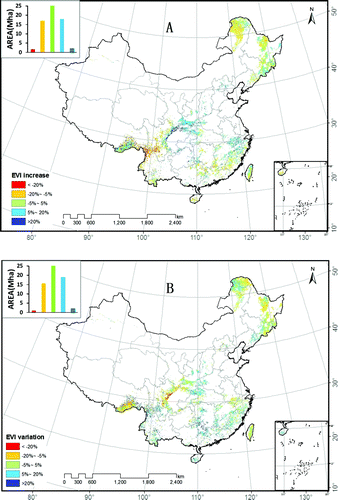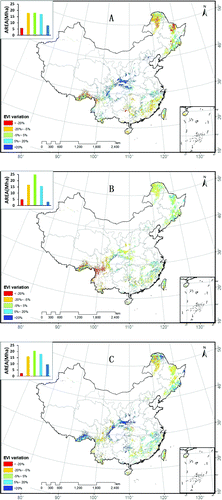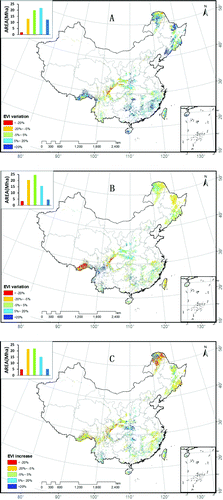Abstract
Variations of forest area and vegetation activity in China from 2001 to 2009 were investigated using the IGBP land-cover data and the EVI (Enhanced Vegetation Index) dataset derived from Moderate-Resolution Imaging Spectroradiometer (MODIS) products in the 3 years of 2001, 2005, and 2009. The area of forests in China had increased by about 10%, and the changes in EVI-indicated vegetation activity showed large regional differences. The EVI decreased between 2001 and 2005 while it increased between 2005 and 2009 in most areas of southern China. It also indicated seasonal differences in different periods: an increase in fall between 2001 and 2005 and in spring between 2005 and 2009.
Introduction
Forest is the widest biome and largest carbon pool on land. It contains c. 80% of the above-ground and 40% of the below-ground carbon in the globe (Kramer Citation1981; Cao and Woodward Citation1998), and therefore plays a significant role in shaping the global carbon cycle and climate change (Pan et al. Citation2011). China has abundant forest resources: forests range from boreal to tropical regions and the planted forest area is the largest in the world (Li et al. Citation2011). It is important to investigate the changes of forests in China for sustainable use of forest resources and better understanding of forest responses to global climate change in China.
The long-term and large-scale remotely sensed vegetation index known as the NDVI (Normalized Difference Vegetation Index) has provided the opportunity to assess vegetation activity and its response to climate change (Wang et al. Citation2003). Such data and methods have been widely applied in China to investigate the temporal and spatial variation of forest vegetation activity and its relation with climate in China. For example, Li and Shi (Citation1999) found that the correlation between the changes of forest vegetation and climate decreased gradually from north to south in China. Fang et al. (Citation2003, Citation2004) and Piao et al. (Citation2003) investigated the dynamic changes in Chinese terrestrial vegetation from 1982 to 1999 and found changes of the terrestrial ecosystems, especially those of forests, were significantly correlated with climatic fluctuation, and these relationships showed remarkable regional differences. Han et al. (Citation2008) also found that the increasing trend of forest activity showed significant regional differences and the main reasons for this increase are the prolonged growing season and the increased vegetation growth.
However, studies show that the NDVI is sensitive to vegetation background. Specifically, the sensitivity of NDVI to vegetation will decline when the vegetation coverage is <15% or >80%, due to the impact of soil background and vegetation saturation (Zhao Citation2003). Compared with the drawbacks of the NDVI data, the EVI (Enhanced Vegetation Index) is suitable for the analysis of forest vegetation change with high vegetation coverage (Liu and Yang Citation2001; Wang et al. Citation2003). In this study, we analyze the interannual and seasonal variations of forest vegetation activity from 2001 to 2009 in China, using the EVI dataset of 2001, 2005, and 2009 from MODIS (Moderate-Resolution Imaging Spectroradiometer) products.
Data and methods
EVI data
The EVI dataset we used is acquired from the MODIS on board NASA's Terra satellite (MOD13A2). It has a spatial resolution of 1 km × 1 km at 16-day intervals. We used 3-year (2001, 2005, and 2009) data to explore the temporal variation of vegetation activity indicated by EVI. In order to reduce the effects of molecular scattering, ozone absorption and stratospheric aerosol, the EVI dataset has been corrected. To further reduce residual atmospheric and bidirectional effect, the Maximum Value Composite (MVC) was applied to produce a monthly EVI dataset (Holben Citation1986). Grid cells with <0.1 of annual average EVI in 2001, 2005, and 2009 were excluded to reduce the influence of clouds and snow.
Average EVI values in the growing season (April to October) in 2001, 2005, and 2009 were analyzed to detect the vegetation activities in China over the study period (2001–2009). The change rates of EVI between 2001 and 2005 and between 2005 and 2009 were also calculated. To investigate the effect of forest type on the vegetation activity, we divided forests in China into five forest types: evergreen needleleaf forest, evergreen broadleaf forest, deciduous needleleaf forest, deciduous broadleaf forest, and the mixed forest. We compared the average EVI in the growing season for these five forest types.
Forest vegetation type
The forest type is classified according to the MODIS IGBP land-cover data product (MCD12Q1) at a spatial resolution of 500 m × 500 m. To make the land-cover and EVI data compatible, we first aggregated grid cells of the land-cover layer into 1 km × 1 km. The variations of forest coverage in the last 10 years were analyzed by comparing coverage areas of the five forest types in 2001, 2005, and 2009.
Spatial patterns of variation in vegetation activity
We analyzed the spatial patterns of variation in vegetation activity. To do this, we chose the constant coverage area, where vegetation type did not change during the two periods (2001–2005 and 2005–2009). We then calculated the rate of variation for each pixel, which were classified into five classes: large decrease (<−20%), decrease (−20% ∼ −5%), nearly no variation (−5% ∼ 5%), increase (5% ∼ 20%), and large increase (>20%). We further calculated the rate of change in spring, summer, and fall in the two periods.
Results and discussion
Variation of forest area
The area of forest in China was 114.3 Mha (106 hectare), 114.3 Mha, and 125.0 Mha in 2001, 2005, and 2009, respectively (). This change varied significantly across different forest types. From 2001 to 2009, the areas of deciduous needleleaf forest and mixed forest increased, while that of deciduous broadleaf did not show a significant change. The area of evergreen forests decreased from 2001 to 2005, but increased from 2005 to 2009. Total forest area also increased from 2005 to 2009 which indicated that the reforestation and afforestation in the last decade significantly increased the forest area in China (Wang et al. Citation2007).
Table 1. Area of different forest types in China from 2001 to 2009.
Variation of vegetation activity
The EVI showed different trends in the different forest types. From 2001 to 2005, EVI of evergreen needleleaf and evergreen broadleaf forests decreased from 0.322 to 0.315, and 0.520 to 0.496, respectively, whereas it increased from 0.329 to 0.338, 0.448 to 0.458, and 0.405 to 0.431 for deciduous needleleaf, deciduous broadleaf, and mixed forests. From 2005 to 2009, the EVI of evergreen needleleaf forest decreased from 0.315 to 0.301, and that of evergreen broadleaf, deciduous needleleaf, deciduous broadleaf, and mixed forest increased from 0.496 to 0.499, 0.339 to 0.343, 0.458 to 0.466, and 0.431 to 0.433 (). This suggests that vegetation activity has been enhanced in most parts of forests in China between 2001 and 2009.
Table 2. EVI of different forest types in China from 2001 to 2009.
Spatial patterns in vegetation activity
The forest vegetation activity did not show a significant change in China from 2001 to 2005. For example, the pixels with large increase (>20% change) were almost equal to those with large decrease (<−20% change), and pixels with increase (5 ∼ 20% change) were similar to the pixels with decrease (−5 ∼ −20% change) (A). However, some regions, for example, the north-west Yunnan Province, showed a large EVI decrease.
Forest vegetation activity increased from 2005 to 2009: pixels with both large increase and increase were more than those with large decrease and decrease (B). However, the EVI showed a large regional difference; for example, a decrease from 2001 to 2009 occurred in northern areas of Mts. Daxing'anling and Mts. Xiaoxing'anling. Deforestation and forest fires may be a cause of this decline (Wang et al. Citation2002; Fang et al. Citation2004).
It is worthy to note that the variations in EVI between 2001 and 2005 were opposite to those between 2005 and 2009 in many areas. For example, at the southeast part of the Tibetan Plateau, EVI increased from 2001 to 2005 (A), but decreased from 2005 to 2009 (B). Also, in most parts of south China, EVI decreased from 2001 to 2005, but increased from 2005 to 2009.
We further analyzed the seasonal variations in forest vegetation activity and found that there were significant regional patterns. In the spring from 2001 to 2005, a large increase in EVI occurred in central China and a decrease in northeast China (A). In the summer season, the area with large decrease was much larger than that with large increase, and significant decrease appeared in the northwestern part of Yunnan Province (B). In the autumn season, pixels with increased EVI were much larger than those with decreased EVI (C).
In the spring from 2005 to 2009, there were more pixels with increasing EVI than those with decreasing EVI (A). In the summer and autumn from 2005 to 2009, there were more pixels with decreasing EVI than those with increasing EVI (B and C).
Conclusions
The area of forests in China did not show a significant change during the years of 2001 to 2005, but increased by about 10% between 2005 and 2009. Different forest types exhibited different patterns: the EVI values of the evergreen needleleaf and evergreen broadleaf forests decreased, whereas those of the deciduous broadleaf, deciduous needleleaf and mixed forest increased. For most forest areas of the country, EVI in the fall increased most between 2001 and 2005, and that in the spring increased between 2005 and 2009.
Acknowledgements
This study was supported by the National Natural Science Foundation of China (#30721140306) and National Basic Research Program of China on Global Change (2010CB950600). We thank Z.Y. Tang for help in editing an earlier version of the manuscript.
References
- Cao , M and Woodward , F I . 1998 . Net primary and ecosystem production and carbon stocks of terrestrial ecosystems and their response to climate change . Global Change Biol , 4 : 185 – 198 .
- Fang , J Y , Piao , S L , Field , C B , Pan , Y D , Guo , Q H , Zhou , L M , Peng , C H and Tao , S . 2003 . Increasing net primary production in china from 1982 to 1999 . Front Ecol Environ , 1 : 293 – 297 .
- Fang , J Y , Piao , S L He , J S . 2004 . Increasing terrestrial vegetation activity in China, 1982–1999 . Sci China, Ser , C 47 : 229 – 240 .
- Han , X Z , Li , S M , Luo , J N and Ji , X . 2008 . China vegetation time-space change research in 20 years . Arid Zone Res , 6 : 753 – 759 .
- Holben , B N . 1986 . Characteristics of maximum-value composite images for temporal AVHRR data . Int J Remote Sens , 7 : 1417 – 1434 .
- Kramer , P J . 1981 . Carbon dioxide concentration, photosynthesis, and dry matter production . BioScience , 31 : 29 – 33 .
- Li , H K , Lei , Y C and Zeng , W S . 2011 . Forest carbon storage in China estimated using forestry inventory data . Sci Silvae Sin , 47 : 7 – 12 .
- Li , X B and Shi , P J . 1999 . Research on regulation of NDVI change of Chinese primary vegetation types based on NOAA/AVHRR data . Acta Bot Sin , 41 ( 3 ) : 314 – 324 .
- Liu , Y J and Yang , Z D . 2001 . The MODIS remote sensing information disposal theory and arithmetic , 232 – 260 . Beijing : Science Press .
- Pan , Y D , Birdsey , R A Fang , J Y . 2011 . A large and persistent carbon sink in the world's forests . Science , 333 : 988 – 993 .
- Piao , S L , Fang , J Y , Zhou , L M , Guo , Q H , Henderson , M , Ji , W , Li , Y and Tao , S . 2003 . Interannual variations of monthly and seasonal NDVI in China from 1982 to 1999 . J Geophys Res Atmos., , 108 ( D14 ) : 4401 doi: 10.1029/2002JD002848
- Wang , G Y , Innes , J L Lei , J F . 2007 . Ecology – China's forestry reforms . Science , 318 : 1556 – 1557 .
- Wang , S Q , Tian , H Q Liu , J Y . 2002 . Characterization of changes in land cover and carbon storage in northeastern China: an analysis based on Landsat TM data . Sci China Ser C Life Sci , 45 : 40 – 47 .
- Wang , Z X , Liu , C and Huete , A . 2003 . From AVHRR NDVI to MODIS EVI: advances in vegetation index research . Acta Ecol Sin , 23 : 979 – 987 .
- Zhao , Y S . 2003 . The remote sensing theory and method of application and analysis , 70 – 305 . Beijing : Science Press .


